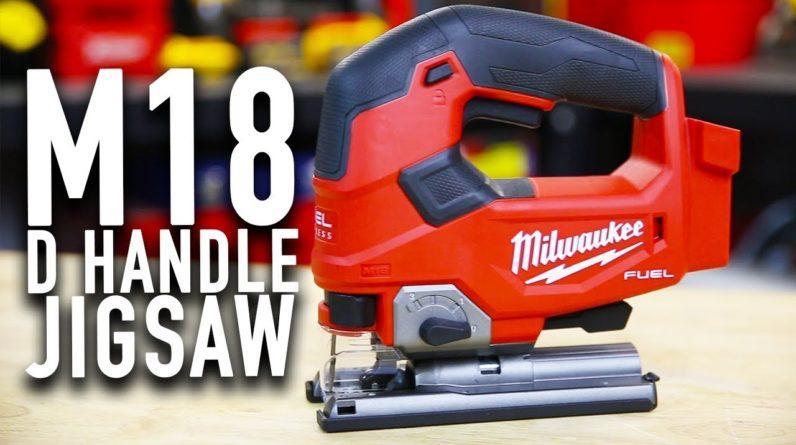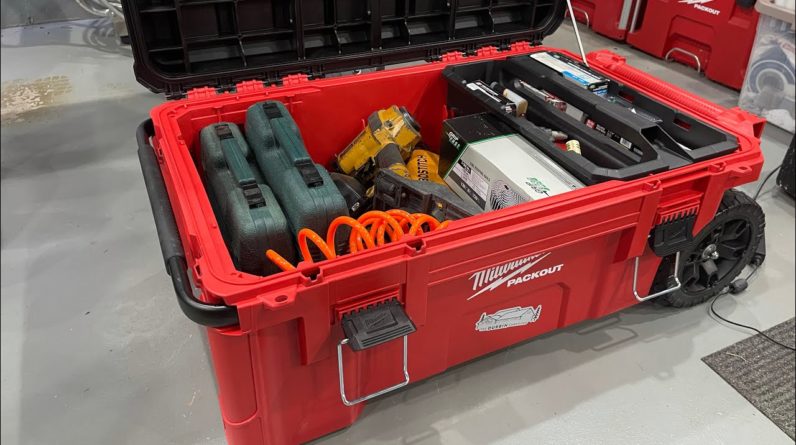Ridgid’s Pro Gear gen 2.0’s all terrain,
large mobile toolbox doesn’t come with mounting brackets like the individual boxes so if
you want to remove the wheels and hang the box, you’ll have to wait until early 2023
when the brackets become available. So given Ridgid’s lack of foresight,
I’m going to build my own large toolbox brackets. Just keep in mind if you build
your own brackets it voids the warranty… I start with a scrap piece of 1/2” plywood…
trace the top of a bracket that came with one of the smaller boxes, and mark the position of
the top mounting hole with a screwdriver or punch. The mounting holes need to be
11” apart, so I measure 11”, and then use a punch to mark the location
of the bottom mounting hole. Line up the punch mark with the hole in the bottom of the
bracket and trace the outline of the bottom. Now to connect the lines.
I’m
making two brackets at once, but it may be easier to make one and then repeat
the process using the first as a template. For the second bracket once again I’ll trace it
out and using a square, make sure the mounting holes line up. Honestly though, it doesn’t need
to be perfect since I’ll be putting a level across the brackets to get the tops lined up. That
way the box isn’t crooked when I mount it . I mark a line on each bracket 1 1/8” from the
top since that’s where the brackets will attach, take everything outside, clamp down the
plywood, and use a jig saw to cut out the forms. The edges don’t need to be perfect at this
point since I’ll sand out rough edges later. Unfortunately as soon as I got set up, it started to lightly rain. Power tools
and rain? Never a good combination. Yes, it looks like I’m
holding two large…. Moving on. For the back of the brackets I grab two 2×2’s, which are actually
1.5×1.5, measure 13” inches, and cut them. The tips of each bracket need
to tapper from 3/8” at the tip, up to the plywood’s 1/2” thickness as shown.
I draw the taper onto the sides of each form so I don’t take off too much material, and
then use an orbital sander to make the taper. Once that’s done I can smooth
out any rough edges on the forms. I test them out to make sure
they insert into the box the same distance and make any necessary adjustments.
Since I’m making two brackets at once, I line up the tops along the non-tapered edges clamp them
and drill 1/8” holes at the marks 11” apart. To make assembly easier, I mark the center of
the 2×2’s, that would be at 3/4 of an inch, and the center of the brackets on the line marked
1 1/8 inches from the top, which was previously marked, and put some temporary holding
screws into the 11” holes I just drilled. Before attaching though make sure the
tapered side is on the same side as the 2×2 or else the brackets won’t
slide into the box properly. On each bracket I mark and pre drill
three 1/8” holes through the center of the brackets, add a counter sink, and
temporarily put in a few 1 5/8”screws. Now I can remove the temporary screws I put
into the mounting holes, which are 11” apart. I use a 5/8” spade bit to make shallow
indents at the holes marked 11” apart and that will accommodate #42 flat washers,
which are 5/8 in diameter with a 1/4” hole. Predrill 1/8” holes through the
mounting holes and into the 2×2’s. Label which pieces go together.
Mark around the 2×2 for reference, and now I can remove the 1 5/8” screws.
For added strength, apply wood glue to the 2×2 and reattach the parts using the 1 5/8”
screws, then do it again on the other bracket. Clamp or screw the top and bottom of each
bracket, wipe any excess glue and let them dry. 24 hours and a wardrobe change later it’s
time to install them according to the mounting instructions that came with my other boxes.
Basically, I figure out where I want them. Draw a line at the top of the 2×2.
Put a
level across it and mark the other stud. Mark 16” on center. Then draw a
line down each stud 16” on center. Mark center on the 2×2. Clamp the first
bracket and check that it’s level vertically. Then I clamp and level the second bracket and
attach both brackets using 3.5” screws and washers. Now If I didn’t have clearance behind
the studs to clamp, I’d have attached the first bracket and then put a level across the top and
mounted the second bracket. Had I needed more holding strength I also could have replaced one
or two of the three 1 5/8” screws between the 11” apart mounting holes with countersunk, 3.5”
screws to penetrate the studs, but it really wasn’t necessary in this case.
The box is going to
store my pneumatic nailing guns and accessories, which aren’t that heavy. Touche Ridgid!
Once I get around to it, I’ll review these Ridgid boxes and the link will appear in the
upper right hand corner of this video. While the boxes don’t hold quite as much as my DeWalt
boxes, they’re just as durable, less expensive, and I like the new mounting feature since it
doesn’t require any special mounting racks. I hope this information has been
helpful. If it has, please do me a favor and hit that “like” button as if
you had to build your own brackets because RIDGID missed their product sales deadline, and
subscribed if you like.
Thanks for watching! Ridgid’s Pro Gear gen 2.0’s all terrain, large mobile toolbox doesn’t come with mounting
brackets like the individual boxes so if you want to mount the wheels. Mount the wheels? No!
RIDGID’s mobile system 2.0 XL moo… Mooble. RIDGID’s progrill… RIDGID’s mo… Ha! I’ll be right
back…. Brrrrrrr…. Let’s try it again. Every time I look at these brackets now I’m just going to
see [bleep]s. Touché RICKET… RICKET. Oh man!.




